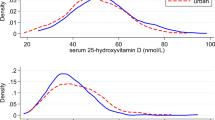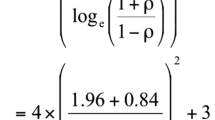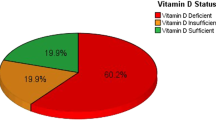Abstract
In this study, we aimed to estimate serum 25-hydroxy vitamin D (25-OH-D) in Asian Indians and test for association between 25-OH-D levels, insulin resistance (IR) and metabolic syndrome (MS). Serum 25-OH-D was measured in a cross-sectional sample of 441 Indians, aged 39.7±12.8 years (237 men and 204 women) with 27.9% prevalence of MS. Vitamin D insufficiency (12.5 to <50 nmol l−1) and hypovitaminosis D (50 to <100 nmol l−1) were present in 65.6 and 31.1% of participants, respectively. The 25-OH-D levels did not differ significantly between sexes (P=0.057). Multivariate regression analysis indicated a positive relationship between 25-OH-D and β-cell function (homeostasis model assessment (HOMA)-B; β=0.245, P=0.006), whereas regression coefficients for fasting glucose (β=0.262, P=0.794), insulin (β=−0.140, P=0.889) and HOMA-IR (β=−0.119, P=0.172) were insignificant. Sex-stratified analysis showed no linear trend for increasing quintiles of 25-OH-D with prevalence of MS or its components (P>0.05). Although highly prevalent, vitamin D insufficient status was not associated with MS or IR in Asian Indians of either sex.
This is a preview of subscription content, access via your institution
Access options
Subscribe to this journal
Receive 12 print issues and online access
$259.00 per year
only $21.58 per issue
Buy this article
- Purchase on Springer Link
- Instant access to full article PDF
Prices may be subject to local taxes which are calculated during checkout
Similar content being viewed by others
References
Ford ES, Ajani UA, McGuire LC, Liu S . Concentrations of serum vitamin D and the metabolic syndrome among US adults. Diabetes Care 2005; 28: 1228–1230.
Pinelli NR, Jaber LA, Brown MB, Herman WH . Serum 25-hydroxy vitamin d and insulin resistance, metabolic syndrome, and glucose intolerance among Arab Americans. Diabetes Care 2010; 33: 1373–1375.
Pittas AG, Lau J, Hu FB, Dawson-Hughes B . The role of vitamin D and calcium in type 2 diabetes. A systematic review and meta-analysis. J Clin Endocrinol Metab 2007; 92: 2017–2029.
Alvarez JA, Ashraf A . Role of vitamin D in insulin secretion and insulin sensitivity for glucose homeostasis. Int J Endocrinol 2010; 2010: 351385.
Chiu KC, Chu A, Go VL, Saad MF . Hypovitaminosis D is associated with insulin resistance and β cell dysfunction. Am J Clin Nutr 2004; 79: 820–825.
Scragg R, Sowers M, Bell C ; Third National Health and Nutrition Examination Survey. Serum 25-hydroxyvitamin D, diabetes, and ethnicity in the Third National Health and Nutrition Examination Survey. Diabetes Care 2004; 27: 2813–2818.
McCarty MF . Poor vitamin D status may contribute to high risk for insulin resistance, obesity, and cardiovascular disease in Asian Indians. Med Hypotheses 2009; 72: 647–651.
Misra A, Vikram NK . Insulin resistance syndrome (metabolic syndrome) and obesity in Asian Indians: evidence and implications. Nutrition 2004; 20: 482–491.
Matthews DR, Hosker JP, Rudenski AS, Naylor BA, Treacher DF, Turner RC . Homeostasis model assessment: insulin resistance and beta-cell function from fasting plasma glucose and insulin concentrations in man. Diabetologia 1985; 28: 412–419.
Zittermann A . Vitamin D in preventive medicine: are we ignoring the evidence? Br J Nutr 2003; 89: 552–572.
National Cholesterol Education Program (NCEP) Expert Panel on Detection, Evaluation, and Treatment of High Blood Cholesterol in Adults (Adult Treatment Panel III).. Third report of the national cholesterol education program expert panel on detection, evaluation and treatment of high blood cholesterol in adults. Circulation 2002; 106: 3143–3421.
Misra A, Vikram NK, Gupta R, Pandey RM, Wasir JS, Gupta VP . Waist circumference cutoff points and action levels for Asian Indians for identification of abdominal obesity. Int J Obes (Lond) 2006; 30: 106–111.
WHO Expert Consultation. Appropriate body-mass index for Asian populations and its implications for policy and intervention strategies. Lancet 2004; 363: 157–163.
Harinarayan CV, Ramalakshmi T, Venkataprasad U . High prevalence of low dietary calcium and low vitamin D status in healthy south Indians. Asia Pac J Clin Nutr 2004; 13: 359–364.
Arya V, Bhambri R, Godbole MM, Mithal A . Vitamin D status and its relationship with bone mineral density in healthy Asian Indians. Osteoporos Int 2004; 15: 56–61.
Wortsman J, Matsuoka LY, Chen TC, Lu Z, Holick MF . Decreased bioavailability of vitamin D in obesity. Am J Clin Nutr 2000; 72: 690–693.
Ruderman N, Chisholm D, Pi-Sunyer X, Schneider S . The metabolically obese, normal-weight individual revisited. Diabetes 1998; 47: 699–713.
Reis JP, von Mühlen D, Kritz-Silverstein D, Wingard DL, Barrett-Connor E . Vitamin D, parathyroid hormone levels, and the prevalence of metabolic syndrome in community-dwelling older adults. Diabetes Care 2007; 30: 1549–1555.
Snijder M, van Dam R, Visser M, Deeg D, Seidell J, Lips P . To: Mathieu C, Gysemans C, Giulietti A, Bouillon R (2005) Vitamin D and diabetes. Diabetologia 48: 1247–1257. Diabetologia 2006; 49: 217–218.
Acknowledgements
We thank all the volunteers who consented to participate in this study. We also thank Dr Shanmughan for his excellent statistical assistance. This study was supported by the Department of Biotechnology, Ministry of Science and Technology, India.
Author contributionVijaya Majumdar researched the data and wrote the manuscript. Dindagur Nagaraja reviewed and edited the manuscript. Rita Christopher researched the data and reviewed and edited the manuscript.
Author information
Authors and Affiliations
Corresponding author
Ethics declarations
Competing interests
The authors declare no conflict of interest.
Rights and permissions
About this article
Cite this article
Majumdar, V., Nagaraja, D. & Christopher, R. Vitamin D status and metabolic syndrome in Asian Indians. Int J Obes 35, 1131–1134 (2011). https://doi.org/10.1038/ijo.2010.232
Received:
Revised:
Accepted:
Published:
Issue Date:
DOI: https://doi.org/10.1038/ijo.2010.232
Keywords
This article is cited by
-
25-hydroxyvitamin D levels are inversely related to metabolic syndrome risk profile in northern Chinese subjects without vitamin D supplementation
Diabetology & Metabolic Syndrome (2022)
-
Association between circulating 25-hydroxyvitamin D and cardiometabolic risk factors in adults in rural and urban settings
Nutrition & Diabetes (2022)
-
Prevalence of vitamin D deficiency and association with metabolic syndrome in a Qatari population
Nutrition & Diabetes (2017)
-
Vitamin D status, hypertension and ischemic stroke: a clinical perspective
Journal of Human Hypertension (2015)
-
The association of vitamin D status with cardiometabolic risk factors, obesity and puberty in children
European Journal of Pediatrics (2014)



